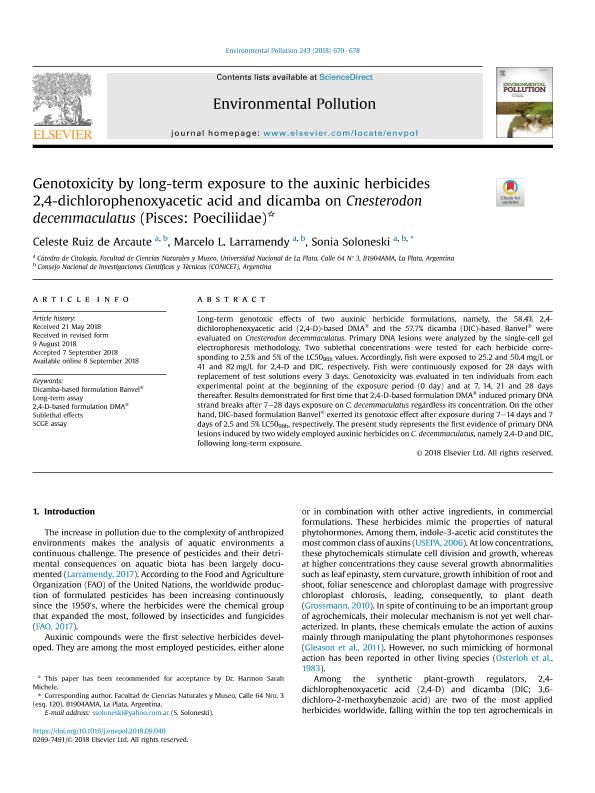Mostrar el registro sencillo del ítem
dc.contributor.author
Ruiz de Arcaute, Celeste

dc.contributor.author
Larramendy, Marcelo Luis

dc.contributor.author
Soloneski, Sonia Maria Elsa

dc.date.available
2019-08-30T18:52:21Z
dc.date.issued
2018-12
dc.identifier.citation
Ruiz de Arcaute, Celeste; Larramendy, Marcelo Luis; Soloneski, Sonia Maria Elsa; Genotoxicity by long-term exposure to the auxinic herbicides 2,4-dichlorophenoxyacetic acid and dicamba on Cnesterodon decemmaculatus (Pisces: Poeciliidae); Elsevier; Environmental Pollution; 243; Part A; 12-2018; 670-678
dc.identifier.issn
0269-7491
dc.identifier.uri
http://hdl.handle.net/11336/82645
dc.description.abstract
Long-term genotoxic effects of two auxinic herbicide formulations, namely, the 58.4% 2,4-dichlorophenoxyacetic acid (2,4-D)-based DMA® and the 57.7% dicamba (DIC)-based Banvel® were evaluated on Cnesterodon decemmaculatus. Primary DNA lesions were analyzed by the single-cell gel electrophoresis methodology. Two sublethal concentrations were tested for each herbicide corresponding to 2.5% and 5% of the LC5096h values. Accordingly, fish were exposed to 25.2 and 50.4 mg/L or 41 and 82 mg/L for 2,4-D and DIC, respectively. Fish were continuously exposed for 28 days with replacement of test solutions every 3 days. Genotoxicity was evaluated in ten individuals from each experimental point at the beginning of the exposure period (0 day) and at 7, 14, 21 and 28 days thereafter. Results demonstrated for first time that 2,4-D-based formulation DMA® induced primary DNA strand breaks after 7–28 days exposure on C. decemmaculatus regardless its concentration. On the other hand, DIC-based formulation Banvel® exerted its genotoxic effect after exposure during 7–14 days and 7 days of 2.5 and 5% LC5096h, respectively. The present study represents the first evidence of primary DNA lesions induced by two widely employed auxinic herbicides on C. decemmaculatus, namely 2,4-D and DIC, following long-term exposure. 2,4-D and dicamba exert primary DNA lesions in blood cells of C. decemmaculatus after long-term exposure.
dc.format
application/pdf
dc.language.iso
eng
dc.publisher
Elsevier

dc.rights
info:eu-repo/semantics/openAccess
dc.rights.uri
https://creativecommons.org/licenses/by-nc-sa/2.5/ar/
dc.subject
2,4-D-Based Formulation Dma
dc.subject
Dicamba-Based Formulation Banvel
dc.subject
Long-Term Assay
dc.subject
Scge Assay
dc.subject
Sublethal Effects
dc.subject.classification
Biología Celular, Microbiología

dc.subject.classification
Ciencias Biológicas

dc.subject.classification
CIENCIAS NATURALES Y EXACTAS

dc.title
Genotoxicity by long-term exposure to the auxinic herbicides 2,4-dichlorophenoxyacetic acid and dicamba on Cnesterodon decemmaculatus (Pisces: Poeciliidae)
dc.type
info:eu-repo/semantics/article
dc.type
info:ar-repo/semantics/artículo
dc.type
info:eu-repo/semantics/publishedVersion
dc.date.updated
2019-08-08T16:13:02Z
dc.journal.volume
243
dc.journal.number
Part A
dc.journal.pagination
670-678
dc.journal.pais
Países Bajos

dc.journal.ciudad
Amsterdam
dc.description.fil
Fil: Ruiz de Arcaute, Celeste. Consejo Nacional de Investigaciones Científicas y Técnicas; Argentina. Facultad de Ciencias Naturales y Museo, Universidad Nacional de la Plata; Argentina
dc.description.fil
Fil: Larramendy, Marcelo Luis. Consejo Nacional de Investigaciones Científicas y Técnicas; Argentina. Facultad de Ciencias Naturales y Museo, Universidad Nacional de la Plata; Argentina
dc.description.fil
Fil: Soloneski, Sonia Maria Elsa. Facultad de Ciencias Naturales y Museo, Universidad Nacional de la Plata; Argentina. Consejo Nacional de Investigaciones Científicas y Técnicas; Argentina
dc.journal.title
Environmental Pollution

dc.relation.alternativeid
info:eu-repo/semantics/altIdentifier/doi/http://dx.doi.org/10.1016/j.envpol.2018.09.040
dc.relation.alternativeid
info:eu-repo/semantics/altIdentifier/url/https://www.sciencedirect.com/science/article/pii/S026974911832267X
Archivos asociados
